5 Tips for a Bee Friendly Yard – Help Save the Bees
What can you do to help the bees? We’ll share how to help save the bees and create a bee friendly yard for honey bees, bumble bees and native bees without spending a ton of money.
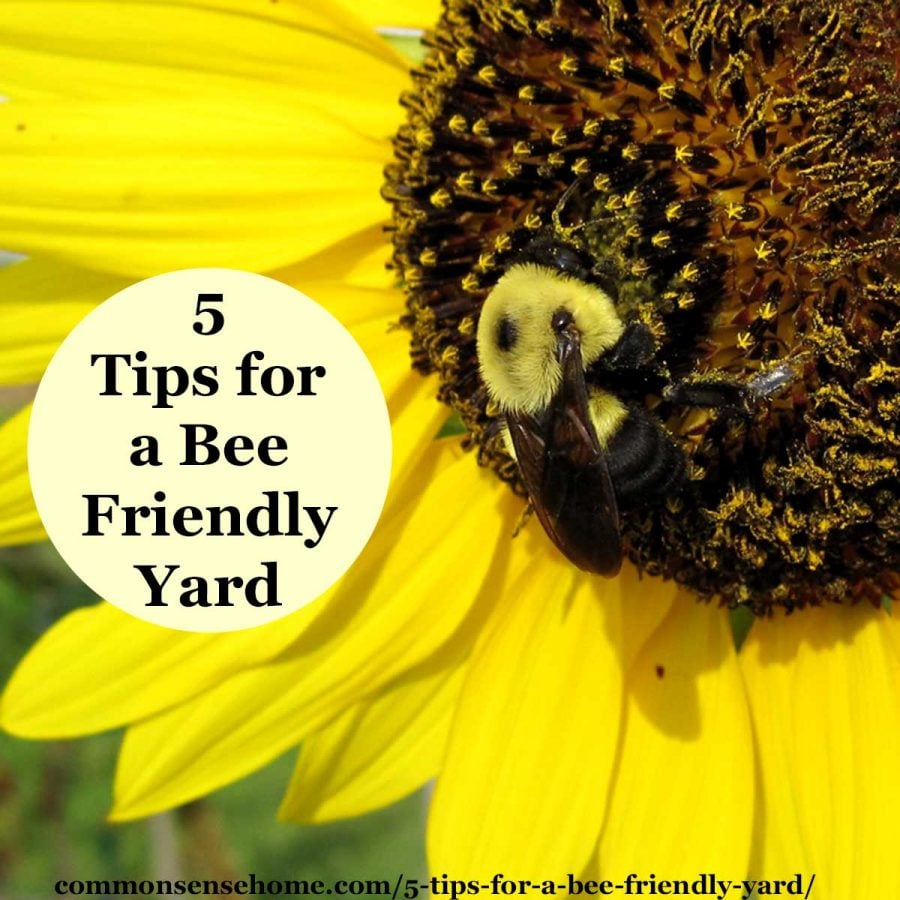
Whether it’s honey bees, bumblebees, mason bees or other native bees, we need our bees. Colony Collapse Disorder (CCD) and varroa mites continue to take a toll on honeybees. The USDA National Agricultural Statistics Service (NASS) states that as of August 2018: Varroa mites were the number one stressor for operations with five or more colonies during all quarters of 2017. There was a 15 percent increase in CCD in Jan-March 2018 compared to the same quarter of 2017.
Hives suffer from mites, pesticides, and limited and contaminated food sources. Rudolf Steiner predicted a bee crisis back in 1923 due to the practice of artificial requeening. Our bees are struggling.
Let’s get started with the small things you can do to help save the bees and make them welcome in your yard.
#1 – Flowers for Bees – Which Flowers are Best for a Bee Friendly Yard?
Bees like flowers that make good landing platforms or tubular flowers with nectar at the base. A variety of flowers will provide food for more of the season.
Think daises, dandelions or snapdragons; not modern hybrids such as double petaled impatiens or massive ruffled roses. Many of the new hybrids are bred for showy color displays, but have very little pollen and nectar. (Some are even bred specifically to shed less pollen for less mess.)
Bees like plants with flower spikes, since the bees can move from flower to flower very quickly. Look for flowers like sage, catnip and goldenrod for your bee friendly garden.
Bees are attracted to blue and yellow flowers the most. They can’t see red! White Dutch clover and other flowering groundcovers provide a grass alternative that can create a bee oasis in the smallest yard.
Whenever possible, try to incorporate native plants into your landscape. They are already adapted to your area, and many perennial species bloom very early or late in the season, before or after annual flowers are at their prime.
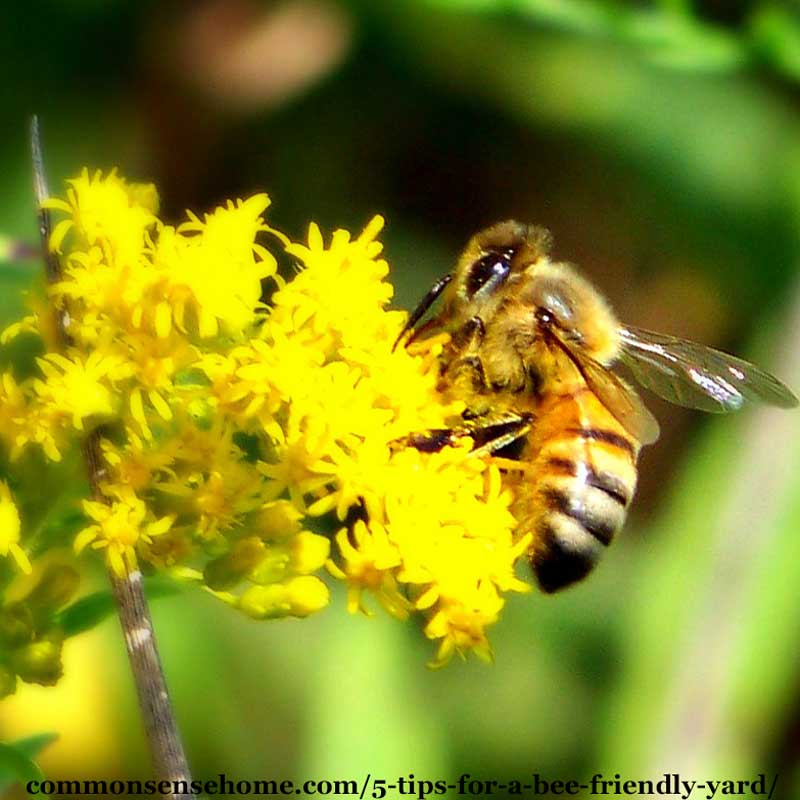
#2 – Use Trees and Shrubs to Help Provide Pollen and Nectar Throughout the Season
Trees and shrubs can provide a flush of pollen and nectar early in the season before other plants have a chance to emerge. They should be a part of almost every yard. Grass lawns offer no shelter and no food to pollinators. In contrast, trees and shrubs offer both food and shelter, creating a microclimate and safe haven of relatively undisturbed habitat.
You want to have a mix of flowering plants to provide food throughout the year. The University of Maine Cooperative Extension offers some suggestions for bee friendly plants:
Early-season Bee Nectar Plants
- Trees: maples, apples, shadbush, willows, cherries, plums, native honeysuckles
- Perennials: blueberries, bugloss, lungwort, pigsqueak, crocus, viola
Mid-season Bee Nectar Plants
- Shrubs: spirea, rose, summersweet, rosebay rhododendron
- Perennials: milkweed, purple coneflower, blazingstar, mint, oregano, bee balm
- Annuals: single-flowered marigold, borage, tickseed, blanketflower
Late season Bee Nectar Plants
- Perennials: aster, bottle gentian, phlox, yellow and purple coneflowers, goldenrod
- Annuals: cosmos, snapdragon
#3 – Have Shallow Water Available for the Bees
Just like everything else, bees need water to survive. If the water container is too deep, they may drown. Place some small stones or floating some pieces of wood in your bird bath, or purchase a bird bath with a very gently sloping outside edge. Bees can’t swim, so they have to be able to access water without treading water.
Would you like to save this?
Bees, butterflies and other insects love fountains and moving water – but mosquitoes don’t, because they need still water to lay their eggs. There are even tiny solar fountains that you can float right in your birdbath for a simple option to create moving water.
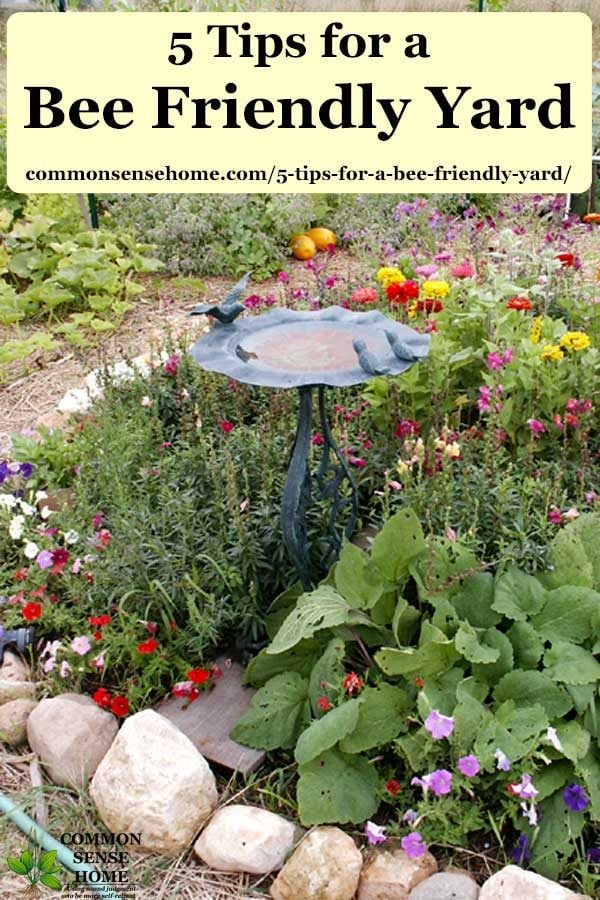
#4 – Avoid Pesticides in Your Bee Friendly Yard
Even “organic” pesticides can be toxic to bees, so please be very, very careful about what you spray in your garden. A report by the Xerces Society indicated that neonicotinoids are of particular concern. Specifically:
- Several of these insecticides are highly toxic to honey bees, bumblebees and other beneficial insects.
- Bees and butterflies eat pollen, which may contain neonicotinoid residues. The residues can reach lethal concentrations in some situations.
- Neonicotinoids can persist in soil for months or years after a single application. Measurable amounts of residues were found in woody plants up to six years after application.
- Untreated plants may absorb chemical residues left over in the soil from the previous year.
- Products approved for homeowners to use in gardens, lawns, and on ornamental trees have manufacturer-recommended application rates up to 120 times higher than rates approved for agricultural crops.
- There is no direct link demonstrated between neonicotinoids and the honey bee syndrome known as Colony Collapse Disorder (CCD). However, recent research suggests that neonicotinoids may make honey bees more susceptible to parasites and pathogens, including the intestinal parasite Nosema, which has been implicated as one causative factor in CCD.
The Center for Food Safety has compiled a list of home and garden products containing neonicotinoids.
#5 – Provide Nesting Sites for Bees
This tip is primarily for the bumblebees and other native bees that don’t live in bee hives. (Of course, sometimes honey bees do form wild hives, but most of us don’t necessarily have the space to accommodate a large wild hive.)
Bumblebees are ground or box nesters, depending on the species. (Old mouse nests are a favorite.) They need a natural, less disturbed area to nest. Try to leave space around yard or garden edges.
Many native bees, such as mason bees, are solitary nesters. They prefer nest blocks or hollow plant stems for shelter. Don’t be too quick to clear out all garden debris! A bundle of sunflower stalks tucked into a corner can make a great nest site.
Kim from EcoBeneficial shares:
70% of our native bee species nest in the ground and must have access to a sunny location with bare soil or very little vegetation. The other 30% of our native bees make their nests in old mouse tunnels, beetle tunnels, holes in trees, pithy plant stems or twigs, and in similar spots.
To help native bees, leave an area of bare soil in a sunny location, keep perennials up over winter as bee nesting cavities, and leave some less tidy areas with old logs and dead trees, cut back to a safe height in highly trafficked areas.
What are you doing to help the bees?
Which bee friendly plants do well in your area? How have you made your yard and garden more bee friendly? I’d love to hear from you!
If you don’t have a spot to make bees welcome, you can support responsible apiaries by buying honey, beeswax and other bee products from trusted sources. (Sometimes cheap honey is more corn syrup than honey.) If you have a local apiary you love, feel free to recommend them in the comments.
Please Share or Pin this post to help make everywhere a little more bee friendly!
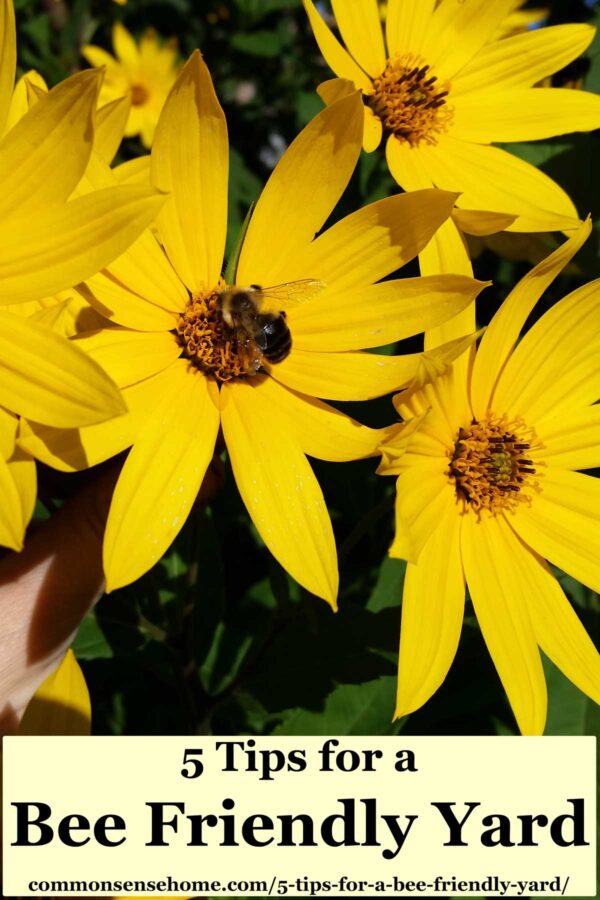
You may also enjoy:
- Beekeeping for Beginners – Natural Backyard Beekeeping
- 7 Reasons You Need Homestead Bees
- Start Beekeeping – Iron Oak Farm’s First Hive
- Honey as Medicine – Prevent Infection, Kill Bacteria, Promote Healing
- 5 Uses for Honey Everyone Should Know
Originally published in 2015, updated in 2019.

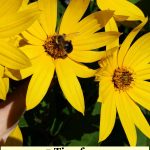
Our borage will self seed, but it germinates fairly late in our northern location. We always start a few indoors in early spring. They are pretty tough, and once hardened off can take a light frost fairly well. This gives our short season garden a little more attention from the bees when they need it. I am ghastly allergic to mosquito bites and wear protection from head to toe all Summer. In early Spring our wild bees buzz pretty fiercely. Being covered up makes it easier to stay calm and still, and lets them decide I am no threat. After that when I’m in the garden the bees don’t exhibit alarm as long as I stay calm and move a bit slowly. ;They seem to regard me as just another garden worker minding my own business. This technique also works for yellow jackets and hornets, though I make an effort to keep a little distance from where they are working even after they have calmed down. I recently heard an interesting comment from a woman who is working with bee keepers to reduce colony loss. She said that it appears bees are seriously affected by emf. This woman manufactures and markets organite, including organite with shungite. Beekeepers are putting shungite, a very unique natural mineral form of fullerite, which was popularized by Buckminster Fuller. It is conventionally a manufactured material which is a very and durable configuration of carbon atoms. Beekeepers can find out more at “Fix the World”, ftw.com
Laurie I love your page. It has a wealth of information on an assortment of topics. You have put a lot of time over the years in providing this and it is truly appreciated. I’m disabled now and not able to be away from home much at all so my backyard is my haven of rest and enjoyment. Bumbles bees are so entertaining for me to sit and enjoy. I have a patch of what I think is creeping Charlie close to where I sit. I’ve counted as many as six bumble bees at a time moving from flower to flower. they are a bit tricky to count. They don’t stay still very long. I will try to incorporate some of your ideas into my haven to provide assistance to them. They are well worth it. Thanks
Bumblebees are my favorite. It’s so soothing watching them work the flowers, and they tend flowers the honeybees will ignore. Each of the native pollinator species have their favorites.
I have almost too many bees and other pollinators here this year. They go crazy particularly for Salvias, which I didn’t notice in the list? Early ones and any Salvia variety. Also Monarda/bergamot ( it might also be called Bee Balm?) Phlox, tithonia , foxgloves, hollyhocks , Zinnias and sunflowers keep mine happily buzzing!
The lists are not comprehensive, just a place to get people started. Thanks for sharing what works well in your yard.
Yes, monarda/bergamot is also known as bee balm, and our bees love it, too. There are so many great options that there’s no reason the bees should need to go hungry in most areas.
I want to start by saying that I’ve become quite a fan of your website (I’m going through every article in my spare time just because it is so interesting!). There is one thing that I was surprised to note regarding having a bee friendly yard which I wanted to share.
I live in a medium/large city on the North shore of Lake Ontario and my backyard faces a park/waterfront open space area that is home to a large variety of wildlife. I was hesitant to garden and purposefully attract bees/insects to my yard as we had quite a wasp problem the first few years I lived here. I was quite amazed to find that as more bees (of all types) came to my yard less wasps made their home here! I wish I would have known this sooner as a potential way to discourage those territorial wasps from invading my house.
I hope this piece of advice helps anyone who may be hesitant to garden for that reason. I have found that it is much easier to coexist with the bee than the wasps. I find the bees are not aggressive (I got stung by wasps when I was bringing the garbage cans to the curb!) and I feel safer letting my kids watch them up close. I am hopeful that the bee population in the area will increase even more in the coming years as the city is planning to transform the fields nearby into a wildlife reserve geared specifically as habitat for monarch butterflies.
Thanks again for all the wonderful info you provide.
I’m glad your enjoy the site, Julie, and thanks for sharing your experience with this. I’ve found similar results – that the native pollinators that move in are docile and tend to hold the territory. Mason bees, for instance, very rarely sting.
Thank you for the info on supporting bees. I recently moved to an older, small mobile home community. I share a love of gardening with many of my neighbors. We plant assorted vegetables, herbs, flowers, succulents h orchids…each of us has our own “specialty”. With a very few exceptions, most practice organic gardening. However, our community is surrounded on 3 sides with farm land. Some organic & some not. We all have noticed a drop in the bee, as well as butterfly, populations, & our doing everything we can think of to support bees, fumbles, butterflies & ladybugs. My place seems to have become a haven for black widow spiders unfortunately. Aside from concerns about my own safety (I’ve a compromised immune system & I’m very sensitive to chemicals & venoms), I’m concerned what few fumbles we have are endangered by these nesting black widows. Any suggestions on how to safely/organically drive away these spiders? Thanks!
We do have an entire post dedicated to reducing spider populations in the home and yard – https://commonsensehome.com/natural-spider-repellents/
They look for certain habitat conditions, so if we can make them and little less comfortable, that helps to reduce the numbers.
Thanks for the link, Laurie—The article & comments were interesting & I hope, helpful. I don’t want to kill the spiders (even Black Widows!), I just want the Widows out of my home, my shed, & much reduced in my yard! 🙂 I have been putting in my garden (I moved here 6 months ago) & have several lavender & mint plants, & am waiting for the lemon verbena to arrive at the local nursery. So garden-wise, it sounds like I’m on the right track. I have some essential oils on hand, & a good source for more nearby, so I’ll try the recommended solutions. Glass spray bottles are recommended, but is plastic ok? Thanks again for your help….hope you & your family have fully recovered from your toxin experience.
Plastic bottles will work for short periods of time, but if the oil mix sits in them, it can eat the plastic.
I have seen ads for stainless steel spray bottles from time to time. Now that we are becoming aware that we are literally drowning in plastic, this has more appeal as a more durable way to keep volatile sprays on hand. Check the gasket to be sure it will not dissolve by contact with essential oil. Nylon should be ok. Not sure about butyl rubber. Cork is glued together bits of cork wook, and may not hold up.
I am a new owner of a smaller than an acre of land in my yard. i would like my whole yard to be a sanctuary for bees and butterflies. made the error of hiring someone last year to “help me green my yard” and my idea of “green” was very different than his, i figured out after he assured me he would turn my lawn green: he used pesticides/herbicides to kill off my white clover, and i was horrified for the rest of the summer, having clover envy. well, i learned my lesson, pained, as neither the bees nor butterflies returned. now i have let my very nice lawn be overgrown with violets and tiny blue flowers. back yard is like a meadow full of buttercups… and i have even seen some bumble bees about! and snails on the buttercups! anyway, i am also disabled thanks to a tick bite in year 2000 that was never caught, so needless to say, ticks (long grass homes of ) force me to use cedar oil and peppermint professionally sprayed to keep them away, so now, please help and advise! what does a person with a small amout of land do to create a sanctuary, while at the same time, avoid ticks? Thank you for any ideas! Save the bees!
How about flowering trees or shrubs? This would provide additional habitat in several ways. What about keeping some less trafficked areas longer, and mowing and treating only where you walk more? The cedar and peppermint are detrimental to good and bad bugs, so less spraying is better.
There’s more detailed information on tick control here – https://commonsensehome.com/natural-tick-repellents/
I have a small herb garden and the bees really love the oregano, marjoram and thyme. I put lime on my lawn to adjust the pH, and now the grass grows fast enough to keep the dandelions in check (I no longer poison or pull them); I also have clover in my lawn and the bees flock to it when it blooms.
I do not know where they nest or what they eat, but I have a lot of small native bees in my yard.
Herbs are wonderful for bees. Thank you for making room for them in your yard.
I planted coneflower, liatris, sunflowers, snapdragons, thyme borage, bee balm and more. There are tons of bees in my garden when i hardly had any. There were three on my white liatris last week. So fun to watch. All the plants are perennials except sunflowers, snaps, and borage, but they all self-sow every year so i don’t really do any work. I harvest the thyme, borage, and bee balm (for tea) for myself as well so i am helping the bees and me! I leave the sunflower seeds for the birds but i harvest the petals for salads. It’s so easy to help the bees by planting the right plants and you get benefited in return with food, cute bees, a showy low-maintenance flower garden, and a fulfilled soul. Just plant. This year i am going to plant lavender, corn flower, and more bee balm colours in any extra space. So exciting
I find it very soothing to listen to the hum of the bees as I work in the garden.
We don’t use a lot of honey, but I always make sure we have a supply of locally harvested honey on hand…local is best, because it can help with allergies…and Manuka is so expensive….
Plant large masses of a single type of a flowering plant, rather than one or two specimen. When the scout bees find a plentiful source of pollen and nectar, they will take the information back to the hive, and the bees will feed on the plants. The smaller specimens will likely be ignored.
Also seek out your local small beekeepers. I’m talking about the people who keep fewer than 10 hives and don’t transport them across the country. The ones who aren’t in your local grocery store because they don’t have the volume needed.
I stumbled on some bee balm seeds this year and decided to plant some. I got hurt right after and couldn’t make it to the yard for a month. When I went out I was blown away by how beautiful it is and how many bees were there. I love watching them. I will be putting your suggestions into play most definitely.
I don’t know what Bee Balm is like. I live in Tasmania, and it could be known by another name here. Could you please enlighten me?
The scientific name of bee balm is Monarda didyma. It’s also known by a number of different common names including Oswego tea and bergamot.
Laurie made excellent suggestions. Since your are a commonwealth country, I thought it might be a good idea to make a distinction between the Monarda didyma var. “Bergamot”, which has a pungent but pleasant citrus-y scent, and the bergamot used to flavor Earl Grey Tea, a citrus called Bitter Orange, whose peel is distilled for its more delicately scented, relaxing and uplifting essential oil also called bergamot. Monarda is in the mint family, is very easy to grow, has many different colored and scented varieties, likes moist conditions. It can also be somewhat invasive, you might want to check wether Tasmania has any restrictions on planting it.
Bees (honeybees especially) love oregano flowers – They also like sage & lavender. Herb gardens are useful & really can attract a lot of bees.
Oh yes! All those are bee favorites in my garden, too! I love working around the fresh herbs.
We have 10 acres of lawn I am no longer mowing much of it and. The wild flowers are growing everywhere clover and dandelions which the bees love. We stopped letting our neighbor use some of our land for crops and now we have a field of wild flowers. We have life back. In the past I never saw a butterflies or bee because of all the farm fields now we hear life all around us
I know we’ve seen a huge increase in diversity of life here since we switched to polyculture from monoculture. Each new mini biome attracts different critters.